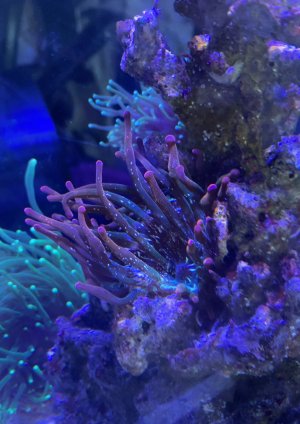You have an Ocellaris clownfish, the scientific name is Amphiprion ocellaris. These are the most common clownfish in the hobby and pretty hardy fish.
I'm not seeing an anemone in your tank. I see several Large Polyp Stony (LPS) corals. I've seen some clowns host in LPS corals over the years but, not very often. Are you thinking these (yellow arrows) are anemones? If so, they are actually LPS corals.
View attachment 32408025
I wouldn't recommend an anemone for your tank for a couple of reasons.
1. Anemones (when first introduced to a tank) tend to wander around until they find a spot they like. In doing so, they can sting other inhabitants killing them. This is magnified in a smaller tank.
2. Anemones can be challenging even for an experienced reef keeper. We generally recommend new hobbyists don't add an anemone until the tank has been up and running for 6-12 months. This gives the hobbyist time to better understand the chemistry and husbandry needed to successfully maintain a reef tank.
3. Anemones can get very large. Some species of anemones can get up to 3 feet in diameter in the wild. I had a carpet anemone years ago in a 200 gallon tank that got 2 feet in diameter.
That said, as
@Reefing102 mentioned, some aquacultured clowns just never end up hosting in anemones. Anemones, while nice for clowns, are not needed for them to thrive.

